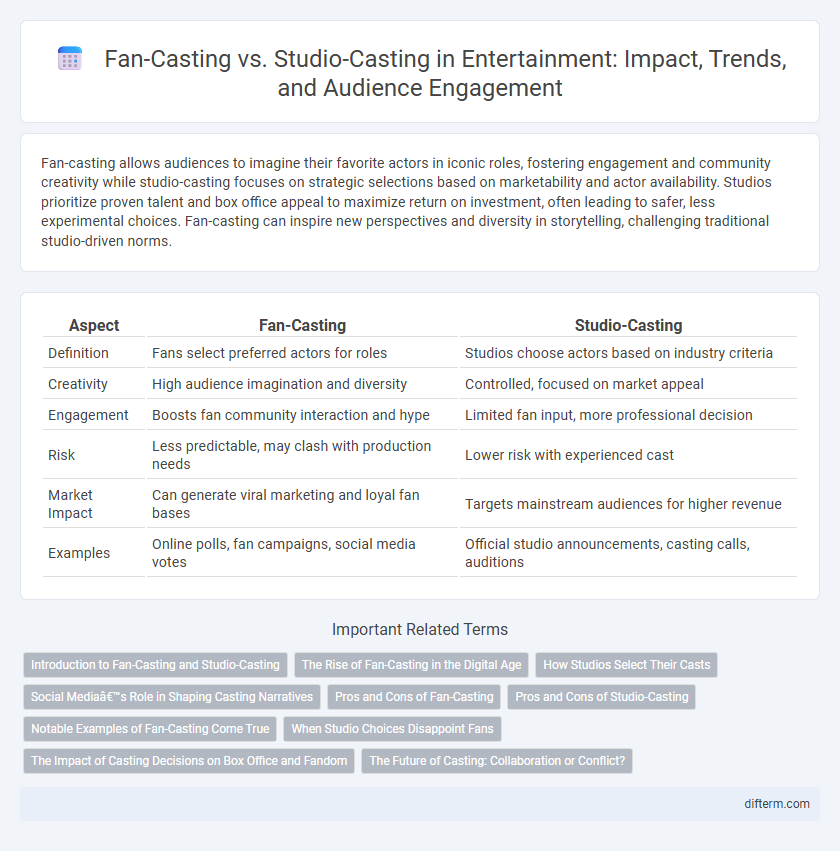Fan-casting allows audiences to imagine their favorite actors in iconic roles, fostering engagement and community creativity while studio-casting focuses on strategic selections based on marketability and actor availability. Studios prioritize proven talent and box office appeal to maximize return on investment, often leading to safer, less experimental choices. Fan-casting can inspire new perspectives and diversity in storytelling, challenging traditional studio-driven norms.
Table of Comparison
| Aspect | Fan-Casting | Studio-Casting |
|---|---|---|
| Definition | Fans select preferred actors for roles | Studios choose actors based on industry criteria |
| Creativity | High audience imagination and diversity | Controlled, focused on market appeal |
| Engagement | Boosts fan community interaction and hype | Limited fan input, more professional decision |
| Risk | Less predictable, may clash with production needs | Lower risk with experienced cast |
| Market Impact | Can generate viral marketing and loyal fan bases | Targets mainstream audiences for higher revenue |
| Examples | Online polls, fan campaigns, social media votes | Official studio announcements, casting calls, auditions |
Introduction to Fan-Casting and Studio-Casting
Fan-casting involves fans of a particular franchise or genre suggesting actors they believe fit specific roles, often generating widespread online discussions and creative engagement. Studio-casting is driven by industry professionals who consider factors like star power, marketability, and contractual obligations to select actors for films and TV shows. Both approaches influence audience expectations and can impact a project's reception and success.
The Rise of Fan-Casting in the Digital Age
Fan-casting has surged in popularity as social media platforms empower audiences to voice their preferences and influence casting decisions, often spotlighting diverse and unconventional talent. This trend challenges traditional studio-casting practices, which rely heavily on industry insiders and established relationships, by democratizing the selection process and increasing fan engagement. Streaming giants like Netflix and Disney+ have begun to acknowledge fan input, reflecting a shift towards more inclusive and audience-driven entertainment experiences.
How Studios Select Their Casts
Studios select their casts through a strategic process involving script analysis, market research, and talent availability to maximize a project's commercial success. Casting directors collaborate with producers and directors to evaluate actors' previous performances, box office appeal, and suitability for specific roles. This method prioritizes not only artistic fit but also audience demographics and potential marketing impact, distinguishing studio-casting from fan-driven selections.
Social Media’s Role in Shaping Casting Narratives
Social media platforms have transformed fan-casting into a powerful tool where audiences directly influence casting narratives by voicing preferences and rallying support for actors in real-time. Studios increasingly monitor trending hashtags and fan campaigns, integrating this data to gauge public interest and potential box office appeal before making casting decisions. This shift democratizes the casting process and creates dynamic interactions between creators, fans, and marketing strategies, reshaping how entertainment projects are developed and promoted.
Pros and Cons of Fan-Casting
Fan-casting leverages the passionate engagement of audiences, often aligning character choices with popular fan interpretations that boost early interest and social media buzz. However, it can lead to unrealistic expectations if fan favorites lack industry experience or fail to meet professional casting standards, potentially impacting overall production quality. Studio-casting offers a more controlled approach with seasoned professionals but may disconnect from audience desires, sometimes resulting in less initial excitement.
Pros and Cons of Studio-Casting
Studio-casting offers advantages such as access to seasoned actors with proven box office appeal and alignment with the director's vision, which can enhance project marketability and cohesion. However, it often limits diversity and fresh talent opportunities, potentially leading to audience fatigue due to repetitive casting choices. Budget constraints and studio preferences may prioritize commercial viability over artistic innovation, impacting creative originality.
Notable Examples of Fan-Casting Come True
Fan-casting often influences studio decisions when passionate communities rally behind specific actors, as seen with Henry Cavill, who was widely fan-cast before being officially chosen as Superman in the DCEU. Another notable example includes Daisy Ridley, who garnered substantial fan support for the role of Rey in Star Wars: The Force Awakens prior to her casting announcement. These instances highlight how fan enthusiasm can align with or even guide studio casting choices, shaping entertainment projects.
When Studio Choices Disappoint Fans
Studio casting decisions often spark disappointment among fans when beloved characters are portrayed by actors who seem misaligned with audience expectations, undermining immersive storytelling. Fan-casting thrives by harnessing community enthusiasm to select actors who embody the essence of characters, fostering deeper engagement and anticipation. Discrepancies between studio selections and fan ideals can lead to backlash on social media, influencing franchise reputations and sometimes prompting recasting or fan-driven campaigns.
The Impact of Casting Decisions on Box Office and Fandom
Fan-casting leverages established fan enthusiasm by aligning actors closely with audience expectations, often boosting initial box office appeal and fostering strong community support. Studio-casting prioritizes commercial viability and star power to maximize market reach, sometimes risking fan alienation but increasing mainstream exposure. The interplay between these casting strategies significantly shapes box office performance and the sustainability of a franchise's fanbase.
The Future of Casting: Collaboration or Conflict?
Fan-casting leverages passionate audience insights to create more authentic character portrayals, while studio-casting relies on industry expertise and market-driven decisions to ensure commercial success. As digital platforms amplify fan voices, studios face increasing pressure to balance creative control with audience engagement, shaping the future of casting as a potential collaboration rather than conflict. The integration of fan input with professional casting processes promises innovative approaches that could redefine entertainment production standards.
Fan-casting vs Studio-casting Infographic

 difterm.com
difterm.com